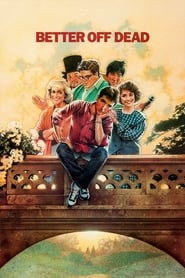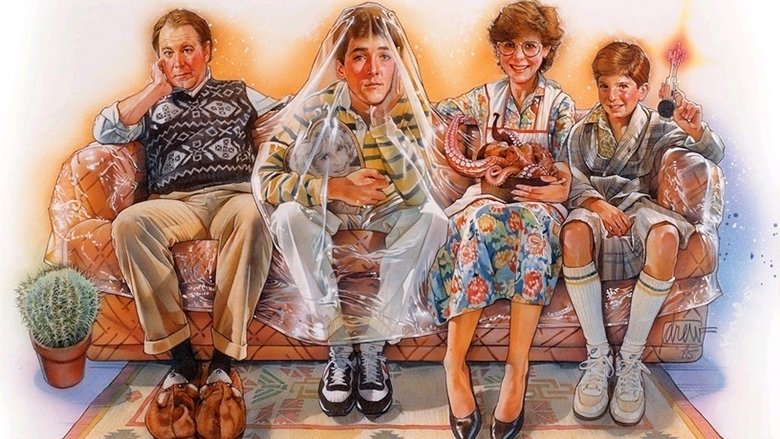“Better Off Dead… 1985” is a quirky comedy film that follows teenage protagonist Lane, who finds himself in a series of absurd, laugh-out-loud situations after being dumped by his girlfriend. With zany characters, outrageous ski competition scenes, and an animated hamburger that haunts Lane’s dreams, this movie explores the struggles of adolescence through a lens of surreal humor and clever one-liners. As Lane navigates heartbreak and attempts to win back his ex-girlfriend, he discovers that life’s challenges can be conquered with resilience and a dash of oddball charm.

CLICK HERE🠣🠣🠣🎞️_Watch Better Off Dead… 1985 English Subtitles_
Review
Better Off Dead…: A Surreal Dive into the Depths of Adolescent Despair
In the sleepy suburb of Clayton, a tale of love, loss, and teenage angst unravels in “Better Off Dead…”, a film that artfully captures the absurdity of life. Directed by Savage Steve Holland, this cult classic paints a vivid portrait of suburban adolescence in 1980s America. Inspired by the literary brilliance of Gabriel Garcia Marquez, this surreal journey takes us deep into the heart and mind of its protagonist.
The storyline revolves around fifteen-year-old Lane Meyer, played by John Cusack with unparalleled vulnerability. After experiencing heartbreak when his girlfriend Beth (Amanda Wyss) dumps him for the charismatic Roy Stalin (Aaron Dozier), Lane plunges into a state of existential crisis. He contemplates suicide but eventually finds solace in two unconventional sources: racing on dangerous ski slopes and his unique bond with his enigmatic neighbor Monique (Diane Franklin).
As we delve deeper into the plot, we discover Lane’s struggle to win back Beth’s affection while simultaneously coping with pressures from his overbearing mother (Kim Darby) and eccentric friends like Charles De Mar (Curtis Armstrong). Despite the seemingly ordinary circumstances, Holland’s deft direction elevates each scene to poetic heights.
Fact or fiction? The truth lies somewhere in between. While “Better Off Dead…” presents itself as a light-hearted comedy, it is deeply rooted in reality. The challenges faced by adolescents navigating love and parental expectations are universal themes that strike a chord with audiences across generations. This is where Gabriel Garcia Marquez’s influence shines through – blending magical realism with everyday encounters to create an otherworldly experience.
The cast brings their characters to life with such conviction that it becomes difficult to discern where fiction ends and reality begins. John Cusack’s portrayal captures Lane Meyer’s innocence perfectly, evoking empathy from viewers who have also tasted the bittersweet concoction of adolescent heartache. Diane Franklin’s Monique, with her impeccable French accent and mysterious allure, adds an enigmatic layer to the narrative.
The history behind the making of “Better Off Dead…” is as fascinating as the film itself. Released in 1985, it faced initial challenges at the box office but soon gained a cult following through word-of-mouth. Critics lauded Holland’s offbeat humor and inventive storytelling, recognizing it as a departure from conventional teen comedies of that era.
What truly sets this film apart is its exceptional score by Rupert Hine. The whimsical melodies enhance every scene, transcending traditional background music to become integral components of the narrative. Popularized tracks like “One Way Love (Better Off Dead)” by E.G. Daily became anthems for a generation struggling with their own romantic entanglements.
When it comes to filming techniques, “Better Off Dead…” showcases Holland’s distinctive vision. The picturesque ski slopes serve as metaphorical battlegrounds for Lane’s internal struggles, juxtaposed against the mundane backdrop of suburban life. This combination creates striking visuals that heighten the emotional impact of each scene – a visual equivalent to Marquez’s ethereal prose.
Awards may not always be synonymous with greatness, yet it is worth mentioning that “Better Off Dead…” received critical acclaim in hindsight. Though overlooked during its initial release, this unconventional gem has garnered recognition as a touchstone for coming-of-age comedies and continues to inspire filmmakers today.
The cinematography deserves special mention for its ability to seamlessly blend reality with dreamlike sequences. As Lane descends into his own personal purgatory, we witness dazzling visuals that transport us into his increasingly surreal world – a reality where hamburgers spontaneously dance and paperboys obsess over collection debts like mythical creatures guarding treasure troves.
Opinions on “Better Off Dead…” vary widely from outright reverence to dismissal as mere frivolity. Some critics praise it as a quirky, introspective commentary on the human condition, while others dismiss it as a forgettable ’80s relic. However, its enduring popularity reinforces its status as a film that appeals to those who relish the strange and thrilling ride of teenage existence.
Gossip occasionally swirls around the production of “Better Off Dead…,” with rumors of on-set romances and clashes between cast and crew. However, the truth lies in the enigmatic abyss that is Hollywood’s behind-the-scenes, permanently hidden from prying eyes.
The unforgettable soundtrack serves as an analysis of Lane’s evolving emotions. Each song complements the narrative arc, amplifying Lane’s triumphs and tribulations. From Van Halen’s pulsating rock anthems to E.G. Daily’s sultry ballads, each track entwines with the dialogue like celestial bodies locked in orbit.
Special effects play a minimal role in “Better Off Dead…”, but when utilized, they leave a lasting impression. As Lane hallucinates his own demise through animated sequences, we are confronted with imagery that could have been plucked from Marquez’s literary universe. These moments transcend reality, blurring boundaries between life and death – an exploration of existential themes rarely seen in teen comedies.
Development challenges plagued “Better Off Dead…” initially due to studio pressure to conform to formulaic storytelling conventions. Holland persisted, fueled by his determination to create something unique and unconventional. Ultimately, this boldness paid off: this film remains an enduring testament to the power of artistic integrity.
The dialogue sparkles with wit and charm – a tapestry woven by Holland’s keen sense of humor. It entrances us with its ability to blend whimsy with profound observations on love and loss; a testament to Holland’s ability to create characters whose every word resonates deeply within our souls.
The crews who brought “Better Off Dead…” to life deserve recognition for their tireless efforts. The seamless integration of practical effects, set design, and costume choices elevate the film from typical ’80s fare to a work of art firmly rooted in its time and place.
Criticism of “Better Off Dead…” often centers around its perceived lack of depth. Some argue that superficiality permeates every aspect of the film, rendering it incapable of transcending its comedic roots. However, this perspective fails to acknowledge the nuanced exploration of Lane’s internal struggles and the juxtaposition between surrealism and reality.
Production on “Better Off Dead…” culminated in a final edit that juxtaposes moments both whimsical and melancholic. In a stroke of genius, Holland masterfully weaves together seemingly disparate threads into a cohesive narrative tapestry that leaves audiences with lingering emotions long after the credits roll.
In summary, “Better Off Dead…” stands as a testament to Savage Steve Holland’s unique vision and fearless storytelling. Its beloved characters, unforgettable quotes, and surreal journey through adolescence continue to captivate viewers decades later. By blending elements of reality with Marquez-inspired surrealism, Holland crafts a truly singular viewing experience that resonates deeply within our hearts and minds – a timeless classic that defies categorization while providing solace to those navigating the tumultuous waters of teenage life.
Technical Data

- Release : 1985-10-11
- Runtime : 97
- Genre : Comedy
- Cast : John Cusack as Lane Meyer, David Ogden Stiers as Al Meyer, Kim Darby as Jenny Meyer, Demian Slade as Johnny Gasparini, Amanda Wyss as Beth Truss
- Crew : Herman F. Zimmerman as Production Design, Caro Jones as Casting, Michael Jaffe as Producer, Tom Kessenich as Key Grip, Alan Balsam as Editor
- Revenue : $10,297,601
- Budget : 0
- Company : A&M Films, CBS Entertainment Productions
- Popularity : 12.339
- Summary : High school student Lane Meyer sinks into suicidal depression when his girlfriend dumps him for jock Roy Stalin, the high school ski racing champion. Meanwhile, he has to deal with his eccentric family, a tenacious paperboy and an obnoxious neighbor whose mother is hosting a beautiful French exchange student named Monique.
- Tagline : Insanity doesn’t run in the family, it gallops.
